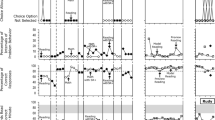Abstract
Over 500 men who attended the Gow School, an independent school for boys with developmental dyslexia, were given a follow-up questionnaire from 1 to 38 years after they left the school. More than half had graduated from college; business was the most frequently chosen major in college; most were employed in managerial or related business positions; and their adult reading habits and attitudes did not compare well with those of other men of similar socioeconomic backgrounds. Socioeconomic status and IQ were not predictive of adult outcome among these men in contrast to their effect in the general population. An important result was that severity of the reading problem upon entrance to Gow and the academic and remedial progress of the men while at the school were highly predictive of adult educational, occupational, and attitudinal status.
Similar content being viewed by others
References
Annett, M. 1981. The right shift theory of handedness and developmental language problems.Bulletin of the Orton Society 31:103–121.
Batheja, M. and McManus, I.C. 1985. Handedness in the mentally handicapped.Developmental Medicine and Child Neurology 27:63–68.
Book Industry Study Group. 1978. Report Number 6. The 1978 Consumer research study on reading and book purchasing.
Briggs, G.G. and Nebes, R.D. 1975. Patterns of hand preference in a student population.Cortex 11:230–238.
Cain, P.S. 1980. Procedures used to produce the fourth edition of “The Dictionary of Occupational Titles.”In A.R. Miller, D.J. Treiman, P.S. Cain et al. (eds.).Work, Jobs, and Occupations: A Critical Review of the “Dictionary of Occupational Titles.” Washington, D.C., National Academy Press.
DeFries, J.C., Singer, S.M., Foch, T.T. and Lewitter, F.I. 1978. Familial nature of reading disability.British Journal of Psychiatry 132:361–367.
DelDotto, J.E. and Rourke, B.P. 1985. Subtypes of left-handed learning disabled children.In B.P. Rourke (ed.).Neuropsychology of Learning Disabilities. New York: Guilford Press.
Finucci, J.M. 1985. Follow-up studies of developmental dyslexia and other learning disabilities.In S. Smith (ed.).Genetics and Learning Disabilities. San Diego: College Hill Press (In press).
Finucci, J.M. and Childs, B. 1981. Are there really more dyslexic boys than girls?In A. Ansara, N. Geschwind, A. Galaburda, M. Albert, and N. Gartrell (eds.)Sex Differences in Dyslexia. Towson, MD: The Orton Dyslexia Society
Finucci, J.M. and Childs, B. 1985. Unpublished data.
Finucci, J.M., Guthrie, J.T., Childs, A.L., Abbey, H. and Childs, B. 1976. The genetics specific reading disability.Annals of Human Genetics 40:1–23.
Finucci, J.M., Isaacs, S.D., Whitehouse, C.C., and Childs, B. 1982. Empirical validation of reading and spelling quotients.Developmental Medicine and Child Neurology 24:733–744.
Geschwind, N. and Behan, P. 1982. Left-handedness: Association with immune disease, migraine, and developmental learning disorder.Proceedings of the National Academy of Science 79:5097–5100.
Gottfredson, L.S., Finucci, J.M., and Childs, B. 1983.The Adult Occupational Success of Dyslexic Boys: A Large-Scale, Long-Term Follow-up. (Report No. 334). Baltimore: Johns Hopkins University Center for Social Organization of Schools.
Gottfredson, L.S., Finucci, J.M., and Childs, B. 1984. Explaining the adult careers of dyslexic boys: Variations in critical skills for high-level jobs.Journal of Vocational Behavior 24:355–373.
Gray, W.S. 1955.Gray Oral Reading Paragraphs Test. Indianapolis: Bobbs-Merrill.
Guilford, J.P. 1967.The Nature of Human Intelligence. New York: McGraw-Hill.
Hardyck, C. and Petrinovich, L.F. 1977. Left-handedness.Psychological Bulletin 84:385–404.
Herjanic, B.M. and Penick, E.C. 1972. Adult outcomes of disabled child readers.The Journal of Special Education 6:397–410.
Horn, W.F., O’Donnell, J.P. and Vitulano, L.A. 1983. Long-term follow-up studies of learning disabled persons.Journal of Learning Disabilities 16:542–555.
Kelley, T.L., Madden, R., Gardner, E.F. and Rudman, H.C. 1922 (rev. 1966).Stanford Achievement Test. New York: Harcourt, Brace, and World.
Morrison, J.C. and McCall, W.A. 1923.Morrison-McCall Spelling Scale. New York: Harcourt, Brace, and World.
Myklebust, H.R. 1971. Learning disabilities and cognitive processes.In H.R. Myklebust (ed.).Progress in Learning Disabilities, Vol. 2. New York: Grune and Stratton.
Nie, N.H., Hull, C.H., Jenkins, J.G., Steinbrenner, K. and Bent, D.H. 1975.Statistical Package for the Social Sciences, 2nd edition. New York: McGraw-Hill.
Orton, S.T. 1937.Reading, Writing, and Speech Problems in Children. New York: Norton.
Polachek, S. 1978. Sex differences in college major.Industrial and Labor Relations Review 31:498–508.
Roemer, R. 1983. Changing patterns of degree selection among women: 1970–1978.Research in Higher Education 18:435–454.
Satz, P., Orsini, D.L., Saslow, E. and Henry, R. 1985. The pathological left-handedness syndrome.Brain and Cognition 4:27–46.
Schonhaut, S. and Satz, P. 1983. Prognosis for children with learning disabilities: A review of follow-up studies.In: M. Rutter (ed.)Developmental Neuropsychiatry. New York: Guilford Press.
Sewell, W.H. and Hauser, R.M. 1975.Education, Occupation, and Earnings: Achievement in Early Career. New York: Academic Press.
Spiegler, B.J. and Yeni-Komshian, G.H. 1983. Incidence of left-handed writing in a college population with reference to family patterns of hand preference.Neuropsychologia 21:651–659.
Spreen, O. 1982. Adult outcomes of reading disorders.In R.N. Malatesha and P.G. Aaron (eds.).Reading Disorders: Varieties and Treatments. New York: Academic Press.
Terman, L.M. and Merrill, M.A. 1937.Measuring Intelligence. Boston: Houghton Miflin.
U.S. Bureau of the Census. 1971.1970 Census of Population Alphabetical Index of Industries and Occupations. Washington, D.C. U.S. Government Printing Office.
Wechsler, D. 1944.The Measurement of Adult Intelligence, 3rd edition. Baltimore: Williams and Wilkins.
Author information
Authors and Affiliations
Additional information
This work was supported by funds from NIH grant HD00486, the Gow School, and the John F. Kennedy Institute.
Rights and permissions
About this article
Cite this article
Finucci, J.M., Gottfredson, L.S. & Childs, B. A follow-up study of dyslexic boys. Annals of Dyslexia 35, 117–136 (1985). https://doi.org/10.1007/BF02659183
Issue Date:
DOI: https://doi.org/10.1007/BF02659183




